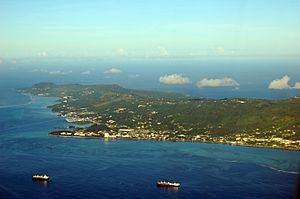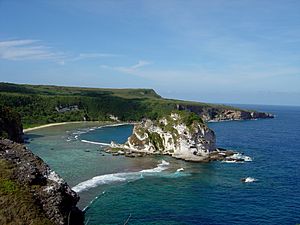Saipan facts for kids
Saipan (IPA: in English) is the largest island and capital of the United States Commonwealth of the Northern Mariana Islands (CNMI), a chain of 15 tropical islands which are part of the Marianas archipelago in the western Pacific Ocean (15°10’51”N, 145°45’21”E) with a total area of 115.39 km² (44.55 sq mi). At the 2000 census, there were more than 62,392 people.
Saipan is at latitude of 15.25° north and longitudeof 145.75° east, about 200 km (120 mi) north of Guam. Saipan is about 20 km (12.5 mi) long and 9 km (5.5 mi) wide. It is a popular tourist destination in the Pacific.
Geography
Saipan is the second-largest island in the Mariana Islands archipelago, after Guam. It is located about 120 mi (190 km) north of Guam and 5 nautical miles (9.3 km) northeast of Tinian, from which it is separated by the Saipan Channel. Saipan is about 12 mi (19 km) long and 5.6 mi (9.0 km) wide, with a land area of 115.38 km2 (44.55 sq mi).
The western side of the island is lined with sandy beaches and an offshore coral reef which creates a large lagoon. The eastern shore is composed primarily of rugged rocky cliffs and a reef. A narrow underwater bank of Marpi Reef lies 28 mi (45 km) north of the Saipan, and CK Reef lies in the west of the island.
The highest elevation on Saipan is a limestone-covered mountain called Mount Tapochau at 1,560 ft (480 m). Unlike many of the mountains in the Mariana Islands, it is not an extinct volcano, but is a limestone formation.
To the north of Mount Tapochau towards Banzai Cliff is a ridge of hills. Mount Achugao, situated about 2 miles north, has been interpreted to be a remnant of a stratified composite volcanic cone whose Eocene center was not far north of the present peak.
Flora and fauna
Saipan's flora is predominantly limestone forest. Some developed areas on the island are covered with Leucaena leucocephala, also known as "tangan-tangan" trees, which were spread broadly some time after World War II. Tangan-Tangan trees were introduced, primarily, as an erosion-prevention mechanism, due to the decimation of the landscape brought on by WWII. Remaining native forest occurs in small isolated fragments on steep slopes at low elevations and highland conservation areas of the island. Coconuts, papayas, and Thai hot peppers – locally called "donni' såli" or "boonie peppers" – are among the fruits that grow wild. Mango, taro root, breadfruit (locally called "Lemai"), and bananas are a few of the many foods cultivated by local families and farmers.
Saipan is home to multiple endemic bird species. Among them: the Mariana fruit dove, white-throated ground dove, bridled white-eye, golden white-eye, Micronesian myzomela and the endangered nightingale reed warbler.
The island used to have a large population of giant African land snails, introduced either deliberately as a food source, or accidentally by shipping, which became an agricultural pest. In the last few decades, its numbers have been substantially controlled by an introduced flatworm, Platydemus manokwari. Unfortunately, possibly due to the flatworm, the native tree-snails also became extinct.
Climate
Saipan has a borderline tropical rainforest climate (Köppen Af)/tropical monsoon climate (Köppen Am), moderated by seasonal trade winds from the northeast from November to March, and easterly winds from May to October. Average year-round maximum temperature is 84 °F or 28.9 °C. There is little seasonal temperature variation, and Saipan has been cited by the Guinness Book of World Records as having the least fluctuating temperatures in the world. However, temperature is affected by elevation; hence the island shows considerable variations between the coastal and mountainous areas.
The drier season runs from December to June and the rainier season from July to November. Typhoon season runs from July to December, and Saipan, along with the rest of the Mariana Islands, is subject to at least one typhoon each year.
Images for kids
-
Thai hot peppers, or Tinian peppers, growing wild.
See also
 In Spanish: Saipán para niños
In Spanish: Saipán para niños












